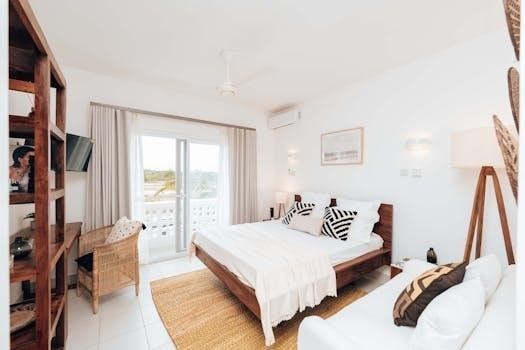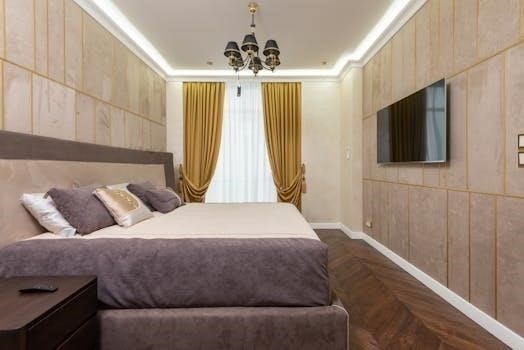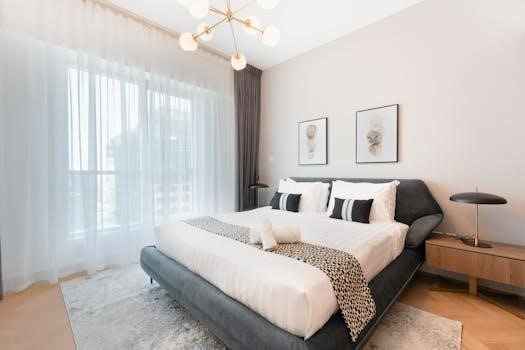Area rugs in bedrooms serve as both aesthetic enhancements and functional additions. Selecting the correct size is crucial, impacting room balance and comfort. This guide focuses on choosing the right area rug for bedrooms, particularly those with queen beds, ensuring the perfect fit and feel.
Why Rug Size Matters in a Bedroom
The size of a rug in a bedroom is paramount for several reasons, extending beyond mere aesthetics. A rug that’s too small can make the room feel disjointed and unbalanced, while one that’s too large might overwhelm the space. The right size, however, creates a sense of cohesion and harmony, grounding the furniture and defining the sleeping area. It also contributes significantly to the room’s overall feel, influencing perceptions of spaciousness and warmth. An appropriately sized rug can make a small bedroom feel larger and a large one feel cozier. Furthermore, the rug size affects the practicality of the space; a rug that is too small may not adequately cover high-traffic areas, leading to uneven wear and tear on the flooring. Conversely, a well-sized rug provides comfortable underfoot cushioning and reduces noise. Ultimately, choosing the correct rug size is essential for both visual appeal and practical living, playing a vital role in creating a bedroom that is both beautiful and functional. It also ensures that the rug adequately complements the bed and other furniture, enhancing the overall design of the room.

Standard Rug Sizes for Queen Beds
For queen beds, two common rug sizes are often recommended⁚ 8×10 and 9×12. These sizes offer good coverage and balance for most queen-sized bed layouts, providing ample space around the bed for a harmonious look.
The 8×10 Rug Option
The 8×10 rug is a popular choice for bedrooms featuring a queen-sized bed, offering a balanced and versatile foundation for the room’s décor. This size generally allows the rug to extend beyond the sides and foot of the bed, providing a soft and comfortable surface to step onto. When placed under a queen bed, an 8×10 rug typically leaves about 18 to 24 inches of rug exposed on each side, which is ideal for creating a cohesive and grounded feel in the room. This extension helps to visually anchor the bed, making it the focal point of the space while also preventing it from appearing isolated or floating.
Furthermore, the 8×10 size is particularly well-suited for smaller bedrooms or those where space is a consideration. It offers enough coverage to define the bed area without overwhelming the room’s dimensions. It is a great choice for those looking to add warmth and texture to their bedroom floor, contributing to an inviting and stylish atmosphere. The balance between the rug’s size and the bed’s dimensions is key to achieving an aesthetically pleasing result, and the 8×10 rug often strikes that perfect balance.
The 9×12 Rug Option
The 9×12 rug is an excellent option for larger bedrooms or those aiming for a more luxurious and expansive feel, especially when paired with a queen-sized bed. This size allows for a significant portion of the rug to extend beyond the bed’s perimeter, typically offering around 24 to 36 inches of rug exposure on all sides. Such generous dimensions create a more visually encompassing space, enhancing the overall sense of grandeur and comfort. The 9×12 rug not only anchors the bed but also helps to unify the entire room, tying together other elements such as bedside tables and seating areas.
For bedrooms where the queen bed is not the sole focus, or where there is additional furniture, the 9×12 rug provides ample coverage to accommodate these arrangements. This size is also ideal for achieving a more high-end look, making the bedroom feel more spacious and well-designed. It’s a particularly good choice for master bedrooms or rooms with higher ceilings, where a larger rug can truly make a statement and contribute to a more polished and elegant atmosphere. The extra coverage also adds an extra layer of warmth and plushness to the floor, making the bedroom feel inviting and luxurious.

Placement Guidelines for Area Rugs
Proper placement of an area rug significantly impacts a bedroom’s aesthetics and functionality. The rug should extend beyond the bed’s sides and foot, creating a balanced and cohesive look. Consider the overall room layout for optimal positioning.
Extending Beyond the Bed
When placing an area rug in a bedroom, a key guideline is to ensure it extends beyond the perimeter of the bed. This isn’t just about aesthetics; it’s about functionality and creating a sense of balance within the room. For a queen-sized bed, the rug should ideally extend at least 12 inches beyond the sides and foot of the bed. This extension allows for a comfortable landing for your feet when getting out of bed, preventing the cold shock of stepping directly onto a hard floor. Furthermore, a rug that adequately extends beyond the bed helps to anchor the bed within the room, making it feel more intentional and less like a floating object. This is particularly important in larger rooms, where a smaller rug can make the bed feel lost and out of place. In practical terms, this means that if you have a queen bed, opting for a rug that is significantly larger than the bed itself is often the best course of action. The visual impact of a rug that is appropriately sized and positioned can transform the entire feel of your bedroom, creating a space that feels both luxurious and comfortable. Remember, the goal is to create a cohesive and harmonious environment, and the way the rug extends beyond the bed is a crucial element in achieving that.

Considering Room Size and Layout
The overall dimensions and arrangement of your bedroom play a pivotal role in rug selection. Smaller rooms benefit from specific strategies, while larger bedrooms offer more flexibility in rug size and placement. Understanding these nuances is key.
Rugs in Small Bedrooms
In smaller bedrooms, the choice of area rug requires careful consideration to avoid overwhelming the space. A common mistake is using a rug that’s too large, which can make the room feel even smaller and cramped. Instead, opt for a rug that is proportional to the bed and the room’s dimensions. A rug that extends slightly beyond the sides and foot of the bed is ideal, usually about 12 inches, creating a sense of expansion. Alternatively, a smaller rug placed at the foot of the bed can also work well, adding warmth and texture without consuming too much floor space. The goal is to define the sleeping area without making the room feel cluttered. Using light colors can help to visually enlarge the space, and simple patterns are often better than bold designs. Avoid placing the rug too close to the walls, leaving some floor space exposed to make the room feel more open. Consider also that the rug is a great way to add a layer of comfort and warmth underfoot in smaller spaces that can often feel cold or bare.
Rugs in Larger Bedrooms
Larger bedrooms offer more flexibility when it comes to choosing an area rug, allowing for bigger sizes that can anchor the space and enhance the overall design. In these rooms, a rug can be used not just to frame the bed but also to define the entire seating or conversation area, if present. An area rug size of 9×12 or even larger can easily accommodate a queen bed and additional furniture, leaving enough rug space to walk on comfortably around the bed. The key is to choose a rug that visually connects the different elements of the room. It should extend beyond the bed and any other furniture groupings, creating a cohesive and inviting look. Don’t be afraid to use bold patterns or colors in larger spaces, as they can help to add personality and depth to the room. The rug can be an opportunity to introduce a focal point or to complement the existing decor. Be sure to maintain balance and proportion when selecting a rug, ensuring that the rug doesn’t overpower the room, but rather enhances its elegance and functionality.

Additional Factors to Consider
Beyond size, rug style, material, and personal preferences play significant roles. Choose materials that match your lifestyle and decor. Consider patterns and colors that complement your room’s aesthetic, adding a touch of personal flair to your space.
Rug Style and Material
The style and material of your area rug are pivotal in defining the ambiance of your bedroom. Consider the overall aesthetic you wish to achieve. For a cozy, warm feel, plush, high-pile rugs made from wool or synthetic fibers like polyester or acrylic are excellent choices. These materials are soft underfoot and add a luxurious touch. Conversely, for a more modern or minimalist look, flatweave rugs crafted from materials like jute, sisal, or cotton offer a sleek, understated elegance. These natural fibers are durable and easy to maintain, making them suitable for high-traffic areas.
When selecting a rug material, think about your lifestyle and practical needs. Wool rugs are known for their durability and natural stain resistance, but they may require professional cleaning. Synthetic rugs are generally more budget-friendly and easier to clean, making them a practical option for busy households. Cotton rugs are soft and versatile, but they may not be as durable as wool or synthetic options. The color and pattern should also harmonize with the existing decor, enhancing the overall appeal of the room. Choose a rug that complements your bedding, wall colors, and other furnishings to create a cohesive and inviting space.
Personal Preferences and Room Decor
Your personal preferences and the existing room decor play a significant role in selecting the ideal area rug. Consider the colors, patterns, and textures that resonate with your style. If your bedroom features a neutral color palette, a rug with bold colors or intricate patterns can add a focal point and visual interest. Conversely, if your room is already vibrant, a rug with subtle tones and simple designs can create a sense of balance and harmony.
Think about the overall mood you want to create. A plush, shag rug can enhance a sense of comfort and relaxation, while a geometric-patterned rug can lend a more contemporary and dynamic feel. The size, placement, and even the shape of the rug should complement your existing furniture and decor. Don’t be afraid to experiment with different styles and materials to find what works best for your personal taste and the overall aesthetic of your bedroom. Ultimately, the perfect rug should not only fit the room’s dimensions but also reflect your unique style and create a space that you love.